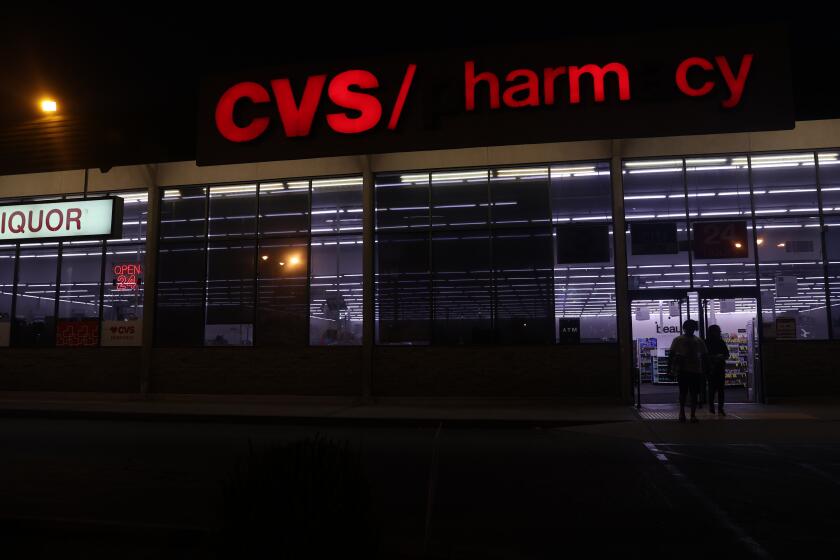3 Credit Card Firms Aim Low to Attract Customers
Three of the nation’s top credit card issuers are engaged in an interest rate battle that has taken the costs of using plastic to new lows for some of their best customers.
First USA, Capital One Financial Corp. and Providian Financial Corp. are currently offering--on a limited basis--a credit card with 7.99% interest rate and no annual fee. It is the lowest rate on a no-fee card ever offered by a national credit card issuer, analysts say.
“It’s a good deal for those who can get it,” said Robert McKinley, president of CardTrak, a Maryland-based consulting firm that tracks low-rate credit cards. “That’s better than what I’m paying on my second mortgage.”
Unlike so-called teaser rates, the card’s 7.99% rate does not expire after a few months.
First USA, the nation’s second-largest credit card issuer, and Capital One, the No. 8 issuer, were reluctant to talk about their 7.99% cards, calling them a “test.” Neither company would say whether the offer will be made widely available.
San Francisco-based Providian says it has moved beyond the pilot phase and added the 7.99% card to its current list of offerings.
But all three companies stressed that the low-rate cards are only available to consumers who receive mail or telephone invitations. None are accepting applications for cards at those rates.
Though the companies declined to discuss their credit guidelines publicly, Providian is reportedly targeting households with good credit records, incomes above $100,000 and debt loads above $10,000.
For those lucky enough to qualify, the 7.99% card offers substantial savings: A cardholder with a $10,000 debt would save about $730 a year in interest, compared with a card at 16%, the industry’s current average.
These offers are the latest salvo in the hotly competitive credit card industry battle for customers, especially the most sought-after consumers--those with perfect credit records, high incomes and big debts.
With millions of credit cards vying for a place in consumers’ wallets, issuers in recent years have offered everything from airline miles to cash-back rewards in an effort to steal one another’s customers.
But card issuers are finding that rather than prizes or points, these potential customers--who often bounce their debts from card to card in search of low teaser rates--would rather find a permanent home for their balances.
“Teaser rates are just not getting the response rates they once did,” said Gerri Detweiler, education advisor at Debt Counselors of America, a nonprofit debt-counseling service. “Consumers are flooded with offers. These low-rate cards are just another step in the marketing push. And I think it’s a good step.”
Some consumers apparently believe the 7.99% offer is too good to be true. Detweiler has received calls from a few skeptical consumers about the new card. “People are so used to teaser rates, they think there must be a catch,” she said.
The three credit card companies are betting that the low-rate offers will give them an edge in the marketplace, where the lowest interest rate currently available on a widespread basis is 9.99%.
“The name of the game is to give people what they want,” said Diane Don, spokeswoman at Falls Church, Va.-based Capital One, which was one of the first issuers to lower the bar last year to 9.99%.
Providian hopes its card will win customer loyalty. “We are trying to attract people interested in a long-term relationship with us, not those people surfing around from card to card searching for a better rate, “ said Laurie Cole, a Providian spokeswoman.
Though a handful of smaller credit card banks--usually located in states with strict usury laws--have offered comparably low rates on their credit cards, such programs typically carry annual fees, have rigorous underwriting criteria or require applicants to open checking accounts. The approval rate for one small bank in Arkansas is less than 10%, CardTrak’s McKinley said.
He also warned that the new low-rate cards usually come with stiff late fees, lower-than-average credit limits and other restrictions.
For example, Providian is offering the low rate only on new purchases, not for existing debts that are transferred from other credit cards. At First USA, the interest rate zooms to nearly 23% if a cardholder is late with payments twice during a six-month period.
The low-rate cards could mark a shift from the industry’s past. Virtually since modern-day credit cards were invented in the 1950s, interest rates have clung stubbornly to the high teens, regardless of the rise and fall of other types of interest rates.
Banks insisted they needed to charge the higher rates to cover the costs of delinquencies and fraud. About 5% to 6% of all credit card debts must be written off by issuers.
But in recent years, consolidation and new technology have been changing the way credit card issuers do business, and consumers are reaping some of the rewards.
Consider the growth of First USA. In the last two years, the Dallas-based issuer has tripled in size to $70 billion in outstanding credit card loans, thanks to mergers with Bank One Corp. and First Chicago Corp. That’s enabled First USA to shave expenses by about 10%.
“Consolidation has made us more efficient,” said Gary Marino, senior executive vice president at First USA. He said the mergers have enabled the company to consolidate processing and other back-office operations, spread technology costs over a greater number of customers and access low-cost deposits from the new bank branches.
Technology also is playing a role. Software programs that can weed out those customers who are likeliest to default or those who never incur interest charges (known in the industry as “free-loaders”) enable credit card issuers to price each customer based on his or her actual costs. In other words, while some customers will enjoy lower rates, others will pay more.
While agreeing that the low-rate cards can save borrowers money, consumer advocates warned that cardholders should remember that terms and benefits on credit cards are subject to change. Issuers reserve the right to change the terms, including the interest rate, at any time and for any reason. Federal law requires companies to give cardholders only 15 days’ notice.
“Consumers need to read the fine print,” said James Frannea, president of the Consumer Credit Counseling Service of Orange County, a nonprofit debt counseling service. “Companies are never bound by the terms.”
To consumers, such changes can feel like bait-and-switch tactics. “I feel they outright lied to me,” said Marcel Blais, an engineer from Portland, Ore. Blais said he responded to Providian’s 7.99% invitation, but when the card arrived in the mail, the interest rate was 12.99%. He immediately canceled the account but still got charged $70 for one month’s interest and a credit insurance policy he said he never requested.
Providian officials said cardholders are evaluated individually based upon their credit history, income and other factors. “We do change offers frequently, but we realize that customers can always vote with their feet,” Cole said.
Steve Gardner, a Dallas attorney who represents consumers, said credit card companies do a poor job of disclosing changes in their card offers, sometimes hoping that consumers won’t notice. He recently represented cardholders in a suit against Advanta Corp. for hiking the interest rates on their cards. The suit was settled--with no admission of wrongdoing--for $7.25 million, but Gardner said it does not appear to have changed industry practices.
“It hasn’t been much of a deterrent,” Gardner said. “People think they are getting a great rate, but it isn’t always the case.”
The Times’ Investment Strategies Conference, to be held May 22-23 at the Los Angeles Convention Center, features a panel on “Money Make-Over: Debt Management and Budgeting.” Times staff writers Kathy Kristof and Liz Pulliam are panelists. For registration information, call (800) 350-3211 or visit http://161.35.110.226/isc.
More to Read
Inside the business of entertainment
The Wide Shot brings you news, analysis and insights on everything from streaming wars to production — and what it all means for the future.
You may occasionally receive promotional content from the Los Angeles Times.










